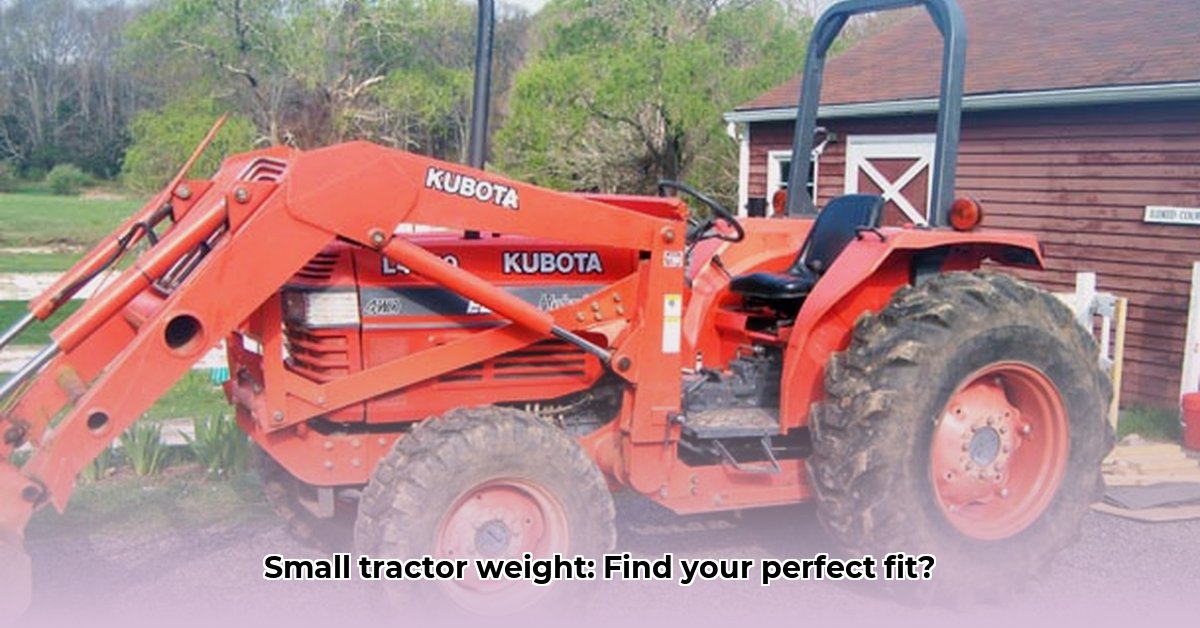
Choosing the right tractor is a crucial decision for any farm. This detailed guide focuses on small tractors (typically 50-75 horsepower), helping you understand their weight variations and how to select the ideal machine for your specific needs. For information on tractor horsepower needs for specific implements, see this helpful resource on tractor power requirements.
What Counts as a "Small" Tractor?
Before diving into weight specifics, let's define "small." We're generally referring to tractors in the 50-75 horsepower range. This size is suitable for numerous farming operations, including orchards and smaller-scale agriculture. However, weight can fluctuate significantly even within this horsepower bracket. Think of it like choosing between a compact car and an SUV—both serve similar purposes but have different weights.
Weight Ranges of Small Tractors: A Detailed Look
A typical small (50-75 hp) tractor's weight can range from 1,900 to 3,000 kilograms (approximately 4,189 to 6,614 pounds). This is a broad estimate; the actual weight depends heavily on the brand, model, features, and additional equipment. This is similar to automotive weights; a basic model will always be lighter than a fully loaded one with additional features.
Here's a table with approximate weight ranges for some popular brands. Note: These are estimates, and you should always verify weight specifications with the manufacturer's official documentation or your local dealer for precise figures.
| Brand | Model (Example) | Approximate Weight Range (kg) | Approximate Weight Range (lbs) | Notes |
|---|---|---|---|---|
| Kubota | BX Series | 1900 - 2300 | 4189 - 5071 | Known for compact, lighter designs |
| John Deere | 5075E | 2052 - 3040 | 4523 - 6699 | Weight varies significantly with options |
| Mahindra | 1526 | 2000 - 2500 | 4409 - 5512 | A good balance of power and weight, often. |
| New Holland | Boomer Series | 2200 - 2800 | 4850 - 6173 | Similar in weight range to other brands |
Factors Affecting Tractor Weight: Understanding the Variables
Several factors significantly impact a tractor's weight:
Engine Size: Larger engines naturally weigh more due to their increased mass and components. More powerful engines generally equate to a heavier overall machine.
Materials and Construction: The types of steel and other materials used in the chassis and components directly affect weight. Higher-grade, stronger steels often weigh more than less robust materials.
Added Features: Optional features like a cab (providing operator protection and climate control), air conditioning, and advanced hydraulic systems all add weight. Every additional feature increases the tractor's overall mass.
Drive Type: Four-wheel-drive (4WD) tractors typically weigh more than two-wheel-drive (2WD) models due to the inclusion of additional drivetrain components. The added weight provides increased stability and traction, but comes at the cost of higher overall mass.
Ballasts and Added Weight: Farmers often add weight to their tractors – typically wheel weights or liquid ballast in the tires – to enhance traction, particularly in challenging conditions such as muddy fields or hilly terrain. This added ballast substantially increases the tractor's total weight.
Matching Tractor Weight to Your Farming Needs: Practical Considerations
Choosing the right tractor weight is not solely about numbers; it's about finding the optimal balance for your specific farming operations. A heavier tractor provides better stability, essential for tasks such as using a front-end loader or working on slopes. However, heavier tractors also consume more fuel and can compact sensitive soils, making them unsuitable for delicate work in orchards or vineyards. Conversely, lighter tractors excel in confined spaces, navigating easily between crop rows.
To determine the appropriate weight for your farm, consider these key factors:
- Land Type and Size: Hilly terrain or significant acreage dictates the need for stability, potentially preferring a heavier tractor. Smaller, flatter plots might benefit from greater maneuverability offered by a lighter model.
- Soil Conditions: Heavy clay soils demand higher weight for improved traction, while lighter, sandier soils are less demanding.
- Typical Tasks: Tasks such as plowing, which require substantial traction, need a heavier tractor. Lighter tasks, such as mowing, may not need the same weight.
- Implement Use: Heavier implements necessitate a heavier tractor to compensate for the added load and maintain optimal performance.
Weight vs. Horsepower: The Relationship and Trade-offs
The relationship between horsepower and weight is complex. Higher horsepower often correlates with increased weight, but not always. Think carefully about your requirements; a lighter tractor may offer sufficient power for specific tasks, making it more fuel-efficient and less prone to soil compaction.
Buying Considerations: Research and Due Diligence
Researching tractor weights can be challenging; specifications may vary across sources. Always consult the manufacturer's official website or your local dealer for the most accurate data. Never rely solely on online sources, always cross-reference information before making a purchase decision. Remember, the tractor's weight directly impacts fuel efficiency, maneuverability, and overall performance.
Conclusion: Making Informed Decisions
Selecting the right tractor involves careful consideration of many factors, with weight being a crucial component. By understanding the influencing variables, assessing your specific farming needs, and conducting thorough research, you can ensure your next tractor purchase perfectly matches your operations. Remember to verify specifications with the manufacturer or your dealer before committing to a purchase. A carefully chosen tractor investment significantly contributes to a farm's overall productivity and success.